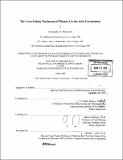| dc.contributor.advisor | C. Forbes Dewey, Jr. and John H. Hartwig. | en_US |
| dc.contributor.author | Hartemink, Christopher Allan, 1974- | en_US |
| dc.contributor.other | Harvard University--MIT Division of Health Sciences and Technology. | en_US |
| dc.date.accessioned | 2008-02-28T16:11:52Z | |
| dc.date.available | 2008-02-28T16:11:52Z | |
| dc.date.copyright | 2005 | en_US |
| dc.date.issued | 2005 | en_US |
| dc.identifier.uri | http://dspace.mit.edu/handle/1721.1/33071 | en_US |
| dc.identifier.uri | http://hdl.handle.net/1721.1/33071 | |
| dc.description | Thesis (Ph. D.)--Harvard-MIT Division of Health Sciences and Technology, 2005. | en_US |
| dc.description | Includes bibliographical references (p. 109-119). | en_US |
| dc.description.abstract | Eukaryotic cells are permeated by a three-dimensional network of entangled filamentous proteins termed the cytoskeleton. Like scaffolding, the cytoskeleton provides rigidity and resistance to deformation from forces transmitted to and from the cell membrane. In order to model the mechanics of the cytoskeleton, the interaction of individual structural proteins must be established. To this end the relationship between two critical proteins of the actin cytoskeleton is examined. Actin reversibly assembles into filaments that provide cells with shape and confer to the cell its mechanical properties. Filamin is an abundant actin-binding protein that efficiently cross-links actin filaments in large-angle orientations, requiring the lowest concentration to convert actin filaments into a cohesive gel. Filamin dimers are composed of two 24-repeat domains that come together like a V with an actin-binding region at each free end. Analysis reveals that the repeat domains of filamin are more flexible than the self-association region of the dimer. These findings dispute the initial claim that filamin is a rigid molecule. This thesis investigates the binding modality of filamin to actin. The structure of filamin bound to actin was compared to filamin in solution and immunogold molecules bound along the filamin rod were used to map the 3-D organization of filamin-actin junctions. There is evidence that filamin binds to actin at more sites than filamin's two established N-terminal actin-binding sites. These features, flexible repeat extensions, multiple-site binding, and a rigid self-association region, make filamin a potent cross-linking agent. | en_US |
| dc.description.abstract | (cont.) The long flexible extensions allow filamin molecules to sample a large volume of cytoplasm in search of an actin target. The binding length of filamin along actin filaments provides a less-flexible linkage from actin to the rigid filamin self-association region, enabling reproducible large angles. At the same time, filamin brings actin filaments into close proximity, creating tight network entanglement, while filamin's angle prevents linked actin filaments from slipping into dense bundles as they do with short cross-linkers like [alpha]-actinin, instead maintaining a strong, disperse network. Tightly constrained junctions support recent entropic and enthalpic models of the cytoskeleton. | en_US |
| dc.description.statementofresponsibility | by Christopher A. Hartemink. | en_US |
| dc.format.extent | 144 p. | en_US |
| dc.language.iso | eng | en_US |
| dc.publisher | Massachusetts Institute of Technology | en_US |
| dc.rights | M.I.T. theses are protected by copyright. They may be viewed from this source for any purpose, but reproduction or distribution in any format is prohibited without written permission. See provided URL for inquiries about permission. | en_US |
| dc.rights.uri | http://dspace.mit.edu/handle/1721.1/33071 | en_US |
| dc.rights.uri | http://dspace.mit.edu/handle/1721.1/7582 | |
| dc.subject | Harvard University--MIT Division of Health Sciences and Technology. | en_US |
| dc.title | The cross-linking mechanism of filamin A in the actin cytoskeleton | en_US |
| dc.type | Thesis | en_US |
| dc.description.degree | Ph.D. | en_US |
| dc.contributor.department | Harvard University--MIT Division of Health Sciences and Technology | |
| dc.identifier.oclc | 62147425 | en_US |
